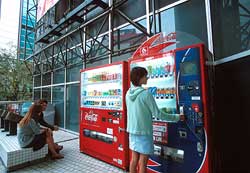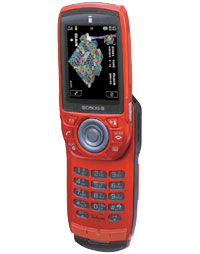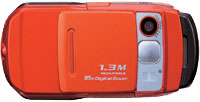Kids Web Japan
Web Japan > Kids Web Japan > Hi-tech > Mobile Phones > Popular Functions
Hi-tech
Mobile Phones
Popular Functions

Some vending machines let users purchase drinks with their mobile phone. (NTT DoCoMo)
While mobile phones are rapidly becoming more common around the world, the ones in Japan have developed some unique functions. Japanese industry is renowned for being able to fit a wide variety of functions into a very compact product, and this ability was key to making mobile phones widespread.
In 1999 mobile phones first became capable of accessing the Internet and sending and receiving e-mail with the appearance of NTT DoCoMo's i-mode service. Other companies followed suit and created original Internet content for mobile-phone users. These sites oriented toward mobile phones have been referred to as a "second Internet." Users of these services at present can use their mobile phones to purchase concert and airline tickets and do their banking. Some cell phones also function in place of a wallet.

 A phone with a built-in digital camera; the lens is on the back. (NTT DoCoMo)
A phone with a built-in digital camera; the lens is on the back. (NTT DoCoMo) Mobile phones with digital cameras attached to them appeared in 2000, and these have proven to be an enormous hit among people in their teens and twenties, even changing the way people communicate. Many people now take commemorative photos whenever they meet their friends and exchange the photos by sending them as e-mail attachments. People can now not only tell their friends where they are and what they are doing, they can show them as well. Sending e-mail, often with pictures and video, is now a more popular means of communication than just talking on the phone. Even in Europe, where many people had once been of the opinion that a digital camera was an unnecessary feature for a mobile phone, this feature is becoming more common as it gains popularity among the younger generations.
Other functions that many users enjoy include simple games and downloadable ring tones, including popular music. Instead of a simple ringer that signals a call, users can select a song or some other sound of their choice to indicate when someone is calling them. This idea has taken the world by storm.
One very unusual feature that has appeared recently is a type of cellular phone that relies on the bones of the user. Instead of putting the speaker against the ear, users can place it against their jaw or skull, and they will hear the person on the other end through the vibrations in their head. This type of phone was originally designed for elderly people with hearing disabilities, but it has been reborn as its usefulness in areas with heavy traffic and loud noise have become apparent.